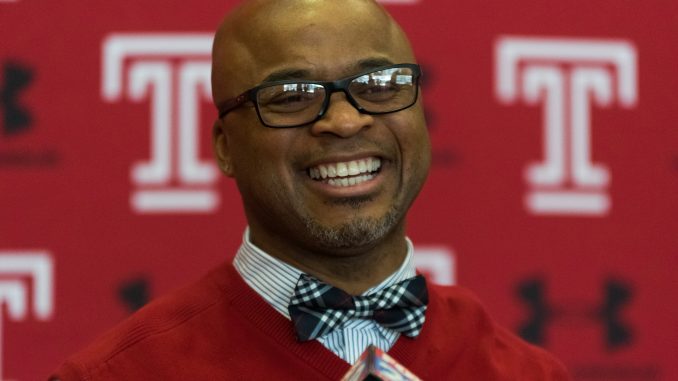
In order to earn consideration for the National Football Foundation’s College Football Hall of Fame, a former player must have earned First-Team All-American honors.
Paul Palmer accomplished that feat in 1986, his final season as an Owl, when he led Division I in rushing yards and all-purpose yards, won the Eastern College Athletic Conference Player of the Year and finished as the Heisman Trophy runner-up.
Palmer, 53, became the second first-round NFL Draft pick in Temple program history in 1987 and earned induction to the Temple Athletics Hall of Fame in 2000. The College Football Hall of Fame, however, eluded him until Monday after seven years on the ballot.
Palmer told reporters during a Monday afternoon press conference that he is “blessed” and “humbled” to be in the class of 10 former players and three coaches who will be inducted on Dec. 4 in New York City and enshrined in the Hall of Fame in Atlanta.
“I had kind of stopped thinking about the Hall of Fame,” Palmer said. “I told myself, ‘It’s not going to happen.’ I told myself, ‘It’s going to be a cold day in hell.’ And as it turns out, it’s a cold day in Philadelphia.”
Thank you @CollegeFBHoF & @NFFNetwork! I’m so excited, & humbled, by this incredible honor. @Temple_FB @HHGarnets @DawgsSports… “WE” (all of us) are going into the #NCAA #HoF together! pic.twitter.com/WlMFpYF9tW
— Paul BooBoo Palmer (@PaulPalmer_6) January 8, 2018
??? @PaulPalmer_6 #TempleTUFF pic.twitter.com/CnDZXDBJ0x
— Temple Football (@Temple_FB) January 8, 2018
“I thought the numbers spoke for themselves, and I thought that the powers that be weren’t looking at the numbers,” Palmer added. “I really felt like they weren’t looking at the numbers. I felt like if they looked at the numbers, the numbers would speak for themselves.”
Palmer became the first former Temple player to earn enshrinement in the College Football Hall of Fame and the fourth Temple representative. Glenn “Pop” Warner, who coached Temple from 1933-38 as part of a 42-year career, Ray Morrison, who coached the Owls from 1940-48, and Wayne Hardin, who coached Temple from 1971-82 and won the most games in school history, are enshrined in the Hall of Fame.
Palmer’s only Division I scholarship offer came from Temple. He’d been receiving interest from East Carolina while in high school in Maryland, he said, but it suddenly stopped.
Palmer later found out that Spencer Prescott, who worked at East Carolina before starting the first of three stints as an assistant at Temple in 1983, took the recruiting questionnaires from East Carolina with him to Temple. Prescott and former Owls’ coach Bruce Arians sought speed, and they thought Palmer had it, Palmer said.
Palmer struggled with ball security early on, he said, fumbling during practices at Geasey Field. Arians told him if he could hold onto the ball, he’d be the best running back in school history.
Palmer left Temple after setting 23 school records and still owns the marks for most rushing attempts, rushing yards, 100-yard games, 200-yard games and all-purpose yards.
Sheldon Morris, who played running back from 1984-87, figured his best shot to get on the field was special teams instead of the backfield.
“I’m sitting like, ‘Oh, God, oh, man,’” Morris said. “‘He’s the same year as I am, so…I’m never going on the field.’”
Palmer listed his vision, or ability to see a hole in the defense and get through it, among his best assets during his career. Though smaller than most players at 5 feet 9 inches, Palmer used his size to his advantage to hide behind his offensive linemen.

Palmer acknowledged his oldest daughter Moet Palmer, a 2011 alumna who died in 2013. He thanked his great-grandmother Frances Palmer, who raised him from the time he was a toddler until she died on the day the Kansas City Chiefs selected him in the 1987 NFL Draft.
He thanked former Temple linebacker and defensive end Haason Reddick, who he coached in high school, for allowing him to be part of his draft night experience in April 2017 after Paul Palmer missed out on his to be with Frances Palmer as her health faded.
Paul Palmer thanked his former teammates as he reflected on his career. Among them, he mentioned John Rienstra, who blocked for Palmer and earned All-American distinction in 1985.
Despite not having played for Temple since 1986, Paul Palmer is very much involved with the football program. He worked as a radio in-game sideline reporter from 2001-04 and has worked as the color commentator since 2013. He wants to use his new Hall of Fame status to advocate for more former Owls to earn recognition.
“Hopefully, if I wiggle my way in, I can slide around to the back door and put a rock in the door and those guys can come on in too,” Palmer said.


Be the first to comment